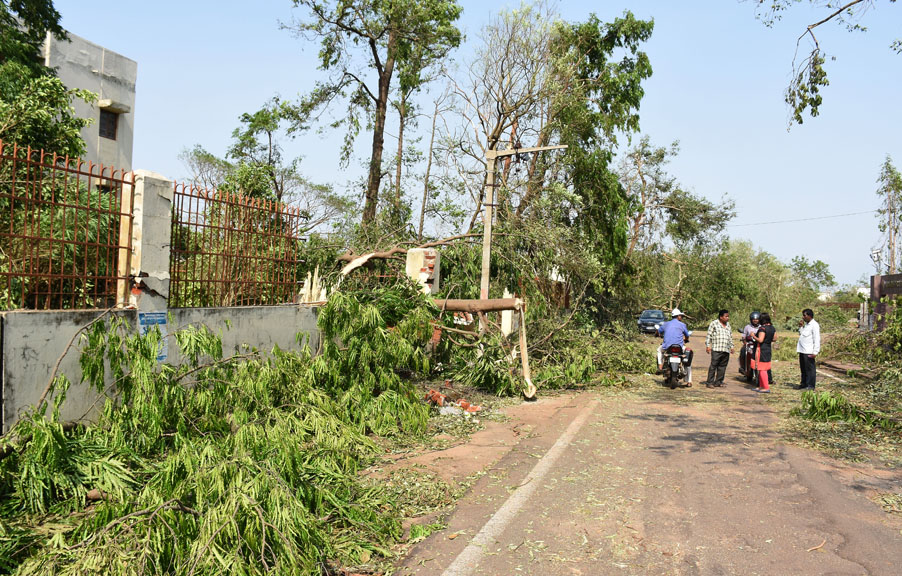It has been almost a month since Cyclone Fani wreaked havoc in the coastal belts of Odisha, damaging infrastructure, property and the natural environment. While cities like Bhubaneswar, Cuttack, Puri and other places that were most affected by the cyclone are still struggling to get back on their feet, restoring and renewing the natural environment is also going to be a difficult and long drawn out task. True, the state’s preparedness in handling natural disasters did not result in too many human casualties this time, but the natural environment has been ravaged.
While over a million people huddled in cyclone shelters and relief camps on the day Fani made landfall, winds raging at around 180-200 kilometres per hour uprooted trees and big shrubs and flung them into the air. With the greenery damaged, the cities today wear a desert look.
Global warming has been cited as the major reason behind the birth of tropical cyclones. According to scientists and weather experts, studies have proven that warmer sea surfaces due to climate change make cyclones not only frequent but also intense.
Indeed, climate change has been a matter of concern in countries worldwide. After the devastating Cyclone Fani, the administration is doing its bit to restore the natural environment in the state, but people too can play a role in rebuilding a green state. Ahead of World Environment Day June 5, Sunday POST describes the efforts being made to restore and protect the natural environment and maintain ecological balance to minimise the threat of natural disasters in the state.
Odisha’s capital Bhubaneswar, which till a month back sported well-manicured gardens and greenery in abundance, today wears a completely different look. “Fani has destroyed the green cover in many areas,” says Suresh Chandra Mohapatra, Principal Secretary, Forest and Environment Department, Odisha. “We have come up with a plan to plant trees that can bear the impact of strong winds caused by cyclones like Fani. Exotic plants cannot withstand strong winds, so we plan to plant 80 lakh saplings in Bhubaneswar, most of which will be cyclone resistant.”
Suresh adds: “We will initiate planting of forest species, which are cyclone resistant. Planting exotic trees like Chakunda, Krushnachuda and Radhachura which cannot withstand wind speed of more than 100 kmph will be discouraged. Instead, the Forest and Environment Department will plant trees like Karanja, Baula and Ashoka, which have strong and deep roots.”
Planting trees, and that too at the earliest, seems to be the only solution given that it takes years for them to grow.
“Planting a tree is a lifelong investment. How well this investment bears fruit depends on the type of tree chosen, the location of the plantation, the care provided during planting those trees and post-plantation care,” says Ranjan Panda, Convener of Combat Climate Change Network.
Ranjan explains that plantations serve a variety of purposes including wood production, soil and water conservation, and, more recently, carbon sequestration. “Growing land use affects biodiversity,” he says.
Understandably, growing land use is the reason behind global warming. However, planting trees simply to make up for lost green cover should not be a hastily taken decision, says Ranjan.
“Plantation and forestation are two different things. Plantation means planting any tree irrespective of environment and composition of the soil, while forestation means planting selected trees which are compatible with the soil of a place. Determining where to plant a tree is a decision that should not be taken lightly. Many factors should be considered prior to planting, such as type of tree, location, and availability of water and sunlight among others,” he adds.
Fani was the first severe summer-time tropical cyclone to hit India in 20 years and experts and environment agencies across the world attribute it to the increasing ocean temperature. Temperature in the Indian Ocean and Bay of Bengal has risen at an alarming rate in the last few years. “High water and air temperatures are crucial to the formation and intensification of cyclones in the ocean. So, global temperature increase is the reason behind frequent formation of cyclones in the Bay of Bengal. This is a result of gradual warming on a global scale, which has resulted in a net increase in ocean temperatures. Global warming has risen because of felling of trees, more land getting used up for houses and roads and growing use of air conditioners,” adds Ranjan.
If we are responsible for global warming, it’s our duty to protect the environment. Prasad K Das, a Bhubaneswar based senior botanist, says, “Fani uprooted many trees and the immediate effect will be increase in temperature, which we are already witnessing. The administration is taking adequate measures to restore the greenery in cities like Cuttack, Bhubaneswar and Puri and coastal belts but the residents of the state also need to work to get back the green cover.”
Prasad suggests that people need to take some conscious decisions to protect the environment. “They should start using public transport instead of their own vehicles. This will decrease carbon emissions and pollution in the cities. Water bodies play a vital role in minimising temperature. Recovery of water bodies in the cities has become essential. Many ponds have been filled up and houses are being built there or the plots are being used as parking places. At the same time, water is being wasted, while these concrete structures are emitting heat. More ponds must be dug, and land should be allocated to plant mangroves on the city’s outskirts. Not only will these plants save the water from going to the sea, but they will also bring down the temperature,” says Prasad.
He adds: “Bullet wood and tamarind trees should be planted on the roadside. These trees are short and have a small canopy and take less time to grow and, at the same time, are cyclone resistant.”
Biodiversity parks on the outskirts of the city can be home for biologically rich wetlands. At the same time, planting a wide variety of fruit-yielding trees and medicinal herbs will not only help in bringing back the recently lost greenery but also aid in maintaining ecological balance.
However, the objective is not only to bring back the lost green cover in the cities but also the coastal belts that saw massive destruction resulting in the uprooting of trees on a large scale. The Balukhand Wildlife Sanctuary on the Puri-Konark marine drive lost more than a million trees. Of the roughly nine million trees in the forest only the mangroves survived the strong winds.
Casuarina and neem trees can survive even in sand dunes. “In Balukhand Sanctuary and Konark, we have decided to plant casuarina and neem trees on a large scale. Cyclone shelter belts in Odisha will be refilled with the required trees. Large-scale mangrove plantation will be done in coastal areas,” informs Suresh.
While many are still lamenting the massive destruction caused by Fani to the state’s environment, others who love their city are coming forward to restore the greenery in their own way.
Munna Das, secretary of Maa Tarini Vihar Development Committee near Durgamadhab Nagar in Bhubaneswar, has mobilised his neighbours to plant saplings before the onset of monsoon. “We have large swathes of open space close to our locality. We have collected funds, put up fences and planted a wide variety of trees including mango, guava, jackfruit and jamun to restore the greenery. Youngsters have been engaged to water the plants in turns,” says Munna.
“We didn’t plant trees immediately after the cyclone as it would be difficult to take care of them in such heat. We are planning to buy some cyclone resistant variety of saplings to plant before monsoon arrives. As the area is yet to be fully connected with government water supply, we will buy water to keep the trees alive,” he adds.
Retired schoolteacher Rabindra Nath Mohanty, a resident of Jaydev Vihar, Bhubaneswar, is a member of quite a few citizen forums in the city. He has worked in government high schools across the state and has been instrumental in promoting the green cause wherever he was posted. He is still distressed about Bhubaneswar losing its green cover following the cyclone. The septuagenarian is encouraging his students, many of whom are now placed in top administrative posts, to contribute to the environment cause.
“I am pained to see the uprooted trees across the city. It is high time the administration makes sincere efforts not only to restore the uprooted trees using modern technology but plant more trees to bring back the lost green cover. Trees are priceless, and the government should save them at any cost,” says Rabindra.
SOYONG, OP

